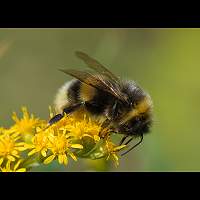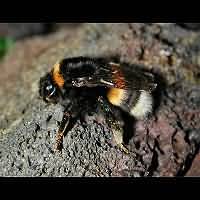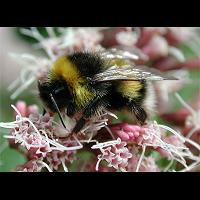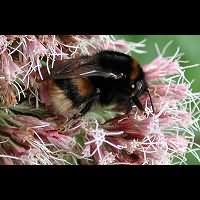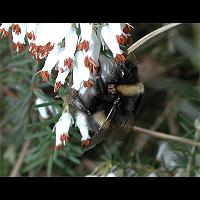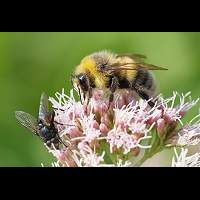Earth Bumblebee Bombus terrestris
The Earth Bumblebee often shows a lot of variation in colouring. In Britain this species has an orange brownish tail, but on the continent the tail is white. In Britain this species is often referred to as the Buff-tailed Bumblebee. As we live in Holland and have white-tailed species only, we will only refer to this species being the Earth Bumblebee. For the same reason we can not show you any pictures of a British specimen. In many gardens this is the biggest species. The queen is always over 2 centimeters long, reaching a wingspan of up to 43 mm. The workers and drones are of a more common bumblebee size: 14 to 17mm in length and the wingspan usually varies between 30 and 35mm. In early spring however the first workers appearing may be a lot smaller. In Britain it is very easy to tell the difference between the Earth Bumblebee and a few of its relatives such as the White-tailed Bumblebee, but once you are on the continent you will have a hard time doing the same thing. The animals in the pictures on this page could very well be Earth Bumblebees, but could also be White-tailed Bumblebees (Bombus lucorum) or even Bombus cryptarum, a non-British species. According to specialists the difference is in the colour of the yellow bands: brownish yellow in the Earth Bumblebee, lemon yellow in the White-tailed Bumblebee and golden yellow in Bombus cryptarum. As one rarely ever sees all species together these descriptions are rather meaningless. An additional problem is that the Earth Bumblebee itself often is quite variable. This means we can not guarantee that all animals depicted below actually are Earth Bumblebees. But we think all of them are.
Not only is the Earth Bumblebee the biggest species to appear in common gardens, it is also one of the earliest. In mild winters the first can be seen flying about in February. And once flying, they keep on doing so for a very long time, sometimes until mid-October. Compared to most other bumblebees their states are very big indeed. In Western Europe a 100 animals occupying one nest may be considered the minimum. But bigger nests may consist of no less than 600 animals. In Southern Europe nests containing over a 1,000 individuals have been found. As you can conclude from its name the Earth Bumblebee constructs its nest in the earth. Usually an empty mouse nest is used. The animals may even enlarge the nest should it be too small to house the entire colony. Every now and then a nest is build above the surface, for instance in an old birds nest or a hay stack. Pirating is quite common in this species, meaning that a queen may locate another queen which already has quite a nest and try to take over. This may lead to bloody fights, often resulting in de death of one of the queens. The Earth Bumblebee is quite capable of adjusting itself to human presence. Various garden plants, even more exotic species, are highly appreciated. In agriculture this is the most popular of all species, being bred at a large scale. It is used in greenhouses to pollinate cucumbers, tomatoes and strawberries. It is also an excellent species for breeding pepper, even though it has to be given additional food, for peppers do not produce any nectar.
The animal in the 3rd picture from the top probably is a worker. The animal in the bottom picture is a drone. All others are likely to be queens.
The Earth Bumblebee often shows a lot of variation in colouring. In Britain this species has an orange brownish tail, but on the continent the tail is white. In Britain this species is often referred to as the Buff-tailed Bumblebee. As we live in Holland and have white-tailed species only, we will only refer to this species being the Earth Bumblebee. For the same reason we can not show you any pictures of a British specimen. In many gardens this is the biggest species. The queen is always over 2 centimeters long, reaching a wingspan of up to 43 mm. The workers and drones are of a more common bumblebee size: 14 to 17mm in length and the wingspan usually varies between 30 and 35mm. In early spring however the first workers appearing may be a lot smaller. In Britain it is very easy to tell the difference between the Earth Bumblebee and a few of its relatives such as the White-tailed Bumblebee, but once you are on the continent you will have a hard time doing the same thing. The animals in the pictures on this page could very well be Earth Bumblebees, but could also be White-tailed Bumblebees (Bombus lucorum) or even Bombus cryptarum, a non-British species. According to specialists the difference is in the colour of the yellow bands: brownish yellow in the Earth Bumblebee, lemon yellow in the White-tailed Bumblebee and golden yellow in Bombus cryptarum. As one rarely ever sees all species together these descriptions are rather meaningless. An additional problem is that the Earth Bumblebee itself often is quite variable. This means we can not guarantee that all animals depicted below actually are Earth Bumblebees. But we think all of them are.
Not only is the Earth Bumblebee the biggest species to appear in common gardens, it is also one of the earliest. In mild winters the first can be seen flying about in February. And once flying, they keep on doing so for a very long time, sometimes until mid-October. Compared to most other bumblebees their states are very big indeed. In Western Europe a 100 animals occupying one nest may be considered the minimum. But bigger nests may consist of no less than 600 animals. In Southern Europe nests containing over a 1,000 individuals have been found. As you can conclude from its name the Earth Bumblebee constructs its nest in the earth. Usually an empty mouse nest is used. The animals may even enlarge the nest should it be too small to house the entire colony. Every now and then a nest is build above the surface, for instance in an old birds nest or a hay stack. Pirating is quite common in this species, meaning that a queen may locate another queen which already has quite a nest and try to take over. This may lead to bloody fights, often resulting in de death of one of the queens. The Earth Bumblebee is quite capable of adjusting itself to human presence. Various garden plants, even more exotic species, are highly appreciated. In agriculture this is the most popular of all species, being bred at a large scale. It is used in greenhouses to pollinate cucumbers, tomatoes and strawberries. It is also an excellent species for breeding pepper, even though it has to be given additional food, for peppers do not produce any nectar.
The animal in the 3rd picture from the top probably is a worker. The animal in the bottom picture is a drone. All others are likely to be queens.

